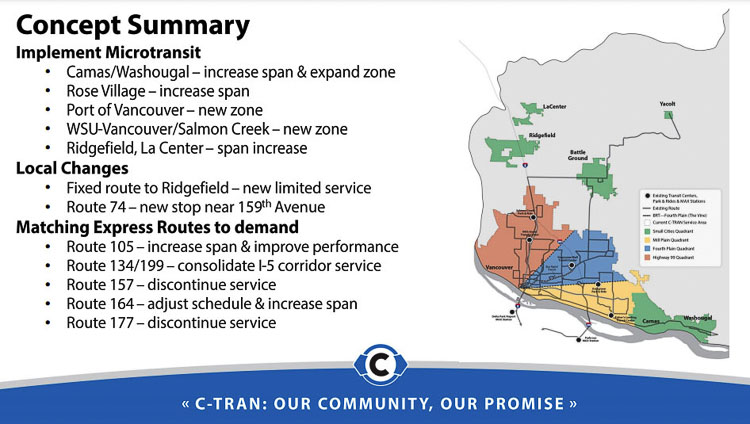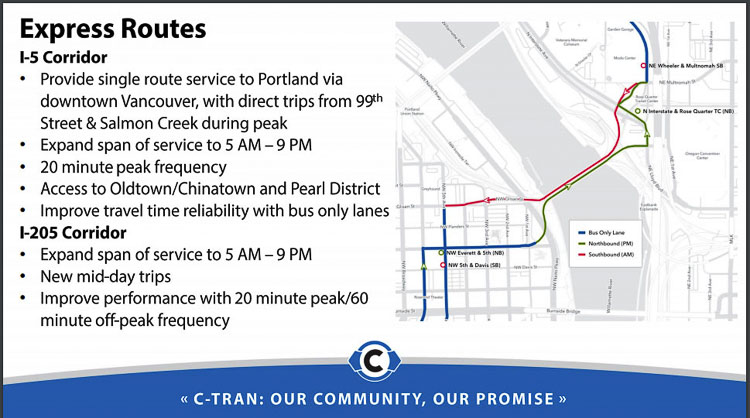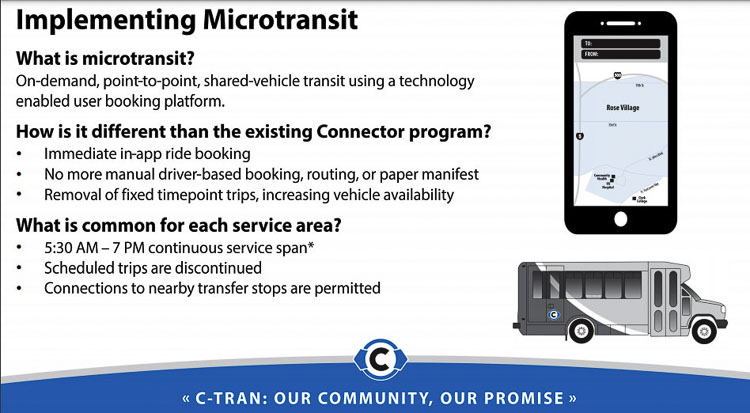New microtransit on-demand service to be offered in east county, Port of Vancouver, and WSU
At a July Board meeting July 13, C-TRAN CEO Shawn Donaghy announced a series of service changes to C-TRAN’s fixed route system. These changes include making service reductions in “express” bus service to Portland which declined due to the pandemic. C-TRAN officials are also proposing service expansions to smaller communities around Clark County.
The board also went into executive session for roughly an hour near the end of the meeting, to review the performance of Donaghy. Emerging from the executive session, board member Ty Stober proposed giving Donaghy a 7 percent pay raise in his salary to $202,257.
The proposed service expansions will include new service into Ridgefield. The Port of Vancouver, WSU, Camas and Washougal will see a new “microtransit” service offered to anyone living within the city limits of each city. Public hearings will be held for the next two months to allow for citizen input before board members make a final decision at their October board meeting.

“We also want to be able to respond to the change in demand that we have been seeing, in particular for the trips over to Portland,” said Scott Patterson, C-TRAN’s head of planning. “We’re also looking to be able to improve our service efficiency as well as our cost effectiveness.”
Cross River service reductions
“We’re looking to better match our services to what we’re seeing for rider demand and what we believe rider demand will look like moving forward,” said Taylor Eidt, senior planner. C-TRAN will take a corridor based approach.
In the I-5 corridor, C-TRAN officials expect to provide a single route service to Portland via downtown Vancouver during all periods, and direct service during morning and evening peak periods from Salmon Creek and the 99th Street park and ride. Eidt says there is demand for earlier and later trips.
Hours of service will be extended with a 20-minute peak, 60-minute off-peak period. C-TRAN will also make a routing adjustment, going through Old Town Chinatown and the Pearl District in Portland.
C-TRAN will consolidate routes 134 and 199; eliminate routes 157 and 177, and adjust service on route 105. For east county crossing I-205, route 164 service will be adjusted from the Fisher’s Landing transit center.
Prior to the pandemic, C-TRAN ridership into Portland had been in decline for several years. Last fall, C-TRAN reported “Commuter ridership has declined 58.2 percent (due to COVID-19). Commuter ridership includes Express bus routes only.”
Average weekday ridership on express routes to Portland:
- 2016 – 3,040
- 2017 – 2,874
- 2018 – 2,844
- 2019 – 2,892
- 2020 — 971
With C-TRAN now proposing permanent reductions in cross river service to Portland, it would seem to raise the need for discussions regarding “high capacity” transit on the Interstate Bridge Replacement Program (IBRP). Administrator Greg Johnson has promised to be “data-driven” and C-TRAN appears to be responding to a significant reduction in demand for cross-river transit service.

Microtransit
C-TRAN’s new microtransit on-demand service using smaller vehicles offers point-to-point service in certain areas. Think of it as C-TRAN’s version of Uber or Lyft, where area residents can use their cellphone to make a reservation for pickup in a relatively short period of time. It is the modernization of C-TRAN’s Connector service.
It is the “implementation of an on demand, point-to-point, shared vehicle transit service with a technology enabled user booking platform, usually in the form of a mobile application,” said Eidt. It will eliminate the current 90-minute reservation window requirement.
The service will transport people from Point A to Point B within a discrete service area, according to C-TRAN. For instance, if you are at Camas High School and want a ride to Washougal High School, it will be a direct trip because both locations are in the same service area. If you are at Camas High School and need to get to a destination outside the Camas-Washougal microtransit zone, you can catch a ride to the nearest fixed-route transfer location.
C-TRAN will eliminate scheduled Connector service in favor of this on demand service. That will free up vehicles to provide the 5:30 a.m. to 7 p.m. continuous service span.
C-TRAN officials also plan two new service areas for the microtransit, serving the Port of Vancouver and WSU Vancouver Salmon Creek. C-TRAN officials hope to attract employees with the port service, and college students and faculty at WSU.
There are six vehicles in their existing fleet that C-TRAN will use for microtransit service. “We plan to bump that number up to eight but will not purchase new vehicles immediately,” said Chris Selk. “We will repurpose the two additional vehicles from our current fleet.”
They are proposing approximately 20,000 service hours for 2022, and estimate a cost of $2.5 to $3 million per year to operate microtransit service.
New Ridgefield service is being offered due to the significant growth that community is experiencing.
C-TRAN plans an extensive public outreach campaign during the summer to allow citizens to weigh in before making any of these proposals permanent. It will include five open house events. Officials expect a formal public hearing at the September Board meeting, and possible approval in October.
Mill Plain BRT
C-TRAN is moving forward with its second $50 million BRT line on Mill Plain that will double the capacity of each bus. Prior to the pandemic, line 37 was carrying about 3,000 people per week day on Mill Plain. (2018 carried 3,044 and 2019 carried 2,985 per week day.)
Line 37 uses 130 total bus trips daily, (Mon.-Fri), carrying about 23 passengers per bus using 2019 pre-pandemic numbers. The 2020 numbers are 1,911 passengers on an average day, according to C-TRAN. That is a 36 percent decline.
C-TRAN recently completed an agreement with Clark College to acquire some land as part of a transit center at their east Vancouver campus on 188th and Mill Plain. It made more sense to C-TRAN officials to have the new bus rapid transit (BRT) system terminate there, to provide closer access to Camas and eastern Vancouver, versus the Fisher’s Landing facility.
According to C-TRAN officials, $4.2 million will be spent to build the transit center at Clark College; 8.4 percent of the total cost.
There’s new development happening just north of the college in the old quarry, so C-TRAN officials believe having a transit center at the college will be a plus for the community.
There were big challenges when the COVID-19 pandemic hit, especially in terms of getting federal financing for the project. “We were one of the only projects in the history of the FTA to receive funding without going through the normal channels,” Donaghy said at a Camas Washougal Chamber luncheon Thursday.
They were able to get the regional FTA administrator to elevate C-TRAN’s BRT request and get it funded outside the normal approval process.

“Scott (Patterson) used the phrase cost effectiveness,” said La Center’s Doug Boff, as he asked what the cost impact would be with the creation of microtransit and expansion of service overall.
Patterson responded by referencing the fact that C-TRAN is currently below their 318,000 budgeted service hours. With these changes they will be around 300,000. “ We really see this as an opportunity to reinvest some of these hours to improve service on this side of the river.”
Donaghy mentioned that they have had conversations with PDX (the Portland airport) officials about creating direct transit service from Clark County. He said 35 or 40 percent of airport employees come from Clark County. No specifics were given on the start of direct service to PDX, but it will initially be from Fisher’s Landing transit center.
CEO salary
At the end of the C-TRAN Board meeting, the board spent time in executive session to assess Donaghy’s performance. When they came out of executive session and went back on the record, they shared praise for C-TRAN and Donaghy’s leadership over the past few years, but especially through the pandemic.
Ty Stober made a motion to raise the CEOs base salary to $202,257. He shared that Donaghy turned down a 3.5 percent raise last year because of the pandemic. He therefore suggested a 7 percent raise to make him whole for the raise he didn’t get last year. The motion was approved unanimously.




